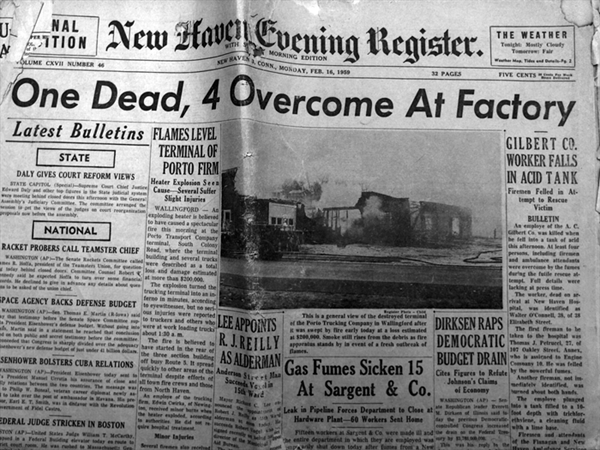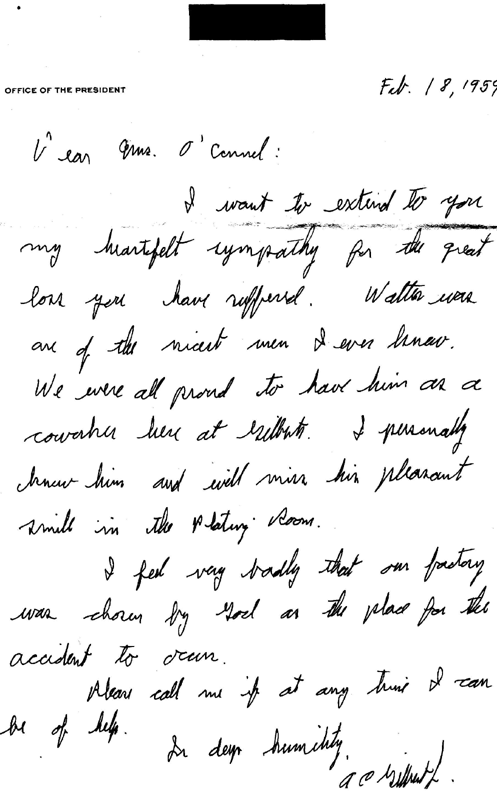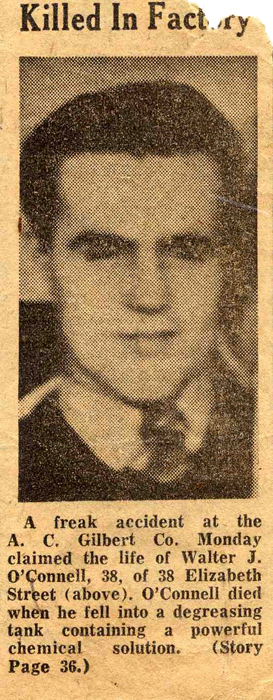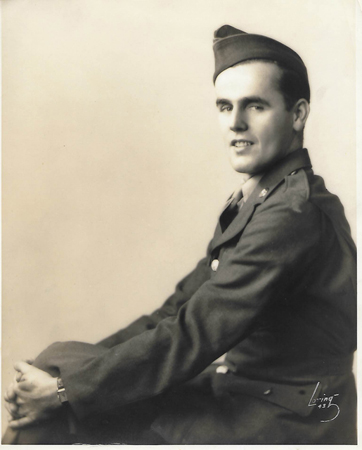The Man Who Stole Paradise:
The Demythologizing of A. C. Gilbert
This article documents how A. C. Gilbert's willful and capricious disregard for the health and safety of his employees led to the death of my father at the age of 38 inside Mr. Gilbert's factory. It further documents how the creation of a mythology surrounding this man by the popular press has cloaked these facts.
Mythology functions as a way of upholding our social structures and institutions, sanctioning the rules that provide for social conformity and creating models of expected behavior. Thus myths have a way of becoming a vital force within a society. To challenge an established myth can be anathema and bring upon oneself the opprobrium reserved for dissidents, outcasts and social deviants. Few people like a whistle blower, an iconoclast or one who might shatter our myths. Thus many historians and writers are quick to embrace the myths of a culture without ever questioning their veracity. Perhaps it's a matter of sloppy journalism by which writers fail to scrutinize the sources and merely recount the errors. It is true that those who do not embrace our popular mythology are often known in the academic community as "revisionists." Such mythology now surrounds the legacy of one Alfred Carlton Gilbert.
The Mythology Of A. C. Gilbert
In the April, 1999 issue of Smithsonian, the historian Bruce Watson published an abstract for his future book on A. C. Gilbert, called "The Man Who Changed How Boys and Toys Were Made". Touting Gilbert as a larger than life almost child-like Renaissance man, Watson waxes nostalgic while relating, in almost canonical fashion, the events that established Mr. Gilbert as "the man who saved Christmas." Thus the mythology of A. C. Gilbert was set in motion.
In fact a quick search of the available literature on Gilbert suggests that he was a kind and loving man, a creative inventor and the savior of boyhood, among other accolades. Even a film about The Man Who Saved Christmas was made for TV.
A. C. Gilbert had many notable achievements in his life. He was a student of medicine at Yale, an inventor, a rather controversial Olympic gold medalist, an avid breeder of German shepherds and perhaps much more. But above all else A. C. Gilbert was a shrewd industrialist.
Throughout the early decades of the twentieth century the A. C. Gilbert Company in New Haven, Connecticut manufactured the popular line of American Flyer trains, Erector sets and more with over 2,500 employees and sales in the 1950s peaking at over seventeen million dollars. Mr. Gilbert lived in great style in North Haven, a then rather quiet suburban town just north of the city. His home was a prodigious estate called Maraldene, now a large tract of land that has been subdivided for about twenty comfortable suburban homes. In addition he bought his own large game farm, a 32 acre property in the neighboring town of Hamden. He called that property Paradise. As an industrialist A. C. Gilbert lived well.
It wasn't always that way, however. In fact Gilbert began his entrepreneurial career as a magician. As such he produced an early line of magic kits from his Mysto Manufacturing Company located in the Westville section of New Haven. With sales flagging and the fledgling company barely making ends meet Gilbert seized upon an opportunity and cashed in on it for the remainder of his life.
In the American press A. C. Gilbert is widely credited with creating the first "Erector Set," a product that made him a very rich man. But where does that credit originate? In his autobiography, The Man Who Lives In Paradise (1954), Gilbert writing of the year 1911, takes the credit ...
"About this time I was riding back and forth from New Haven to New York a good deal -- the section being electrified by the New York, New Haven & Hartford Railroad. I looked out the window and saw steel girder after steel girder being erected to carry the power lines. I found it interesting to watch their progress from week to week, and most other travelers did too. It seems the most natural thing in the world that I should think about how fascinated boys might be in building things out of the girders. My increasing association with the toy business set me thinking in that general direction, too. Anyway, that's where the idea for the Erector came from. Sometime when you are riding on the New York, New Haven & Hartford, you can see that the girders supporting the wires look a good deal like Erector girders. "I suppose the idea was germinating in my mind during several trips, but it seemed to come to me all of a sudden in the fall of 1911. I went right home and got some cardboard to cut out girders. I fiddled with the cardboard until I had several different lengths and shapes out of which many things could be built, then I went to the shop and had one of the machinists make a set out of steel. When I saw that sample I knew I had something. "I got a box of bolts and nuts and started putting the pieces together... " |
So the credit
clearly comes from Gilbert himself. He is the lone source of his "invention."
Yet consider this entry from the Wikipedia ... http://en.wikipedia.org/wiki/Meccano
Anyone with even the most rudimentary knowledge of the "Erector Set"
should recognize its true origins.
| In 1901 Frank Hornby, a clerk from Liverpool, England, invented and patented a new toy called "Mechanics Made Easy" that was based on the principles of mechanical engineering. It was a model construction kit consisting of perforated metal strips, plates and girders, with wheels, pulleys, gears, shaft collars and axles for mechanisms and motion, and nuts and bolts to connect the pieces. The perforations were at a standard 1⁄2 inch (12.7 mm) spacing, the axles were 8-gauge, and the nuts and bolts used 5/32 inch BSW threads. The only tools required to assemble models were a screwdriver and spanners (wrenches). It was more than just a toy: it was educational, teaching basic mechanical principles like levers and gearing. The parts for Hornby's new construction kit were initially supplied by outside manufacturers, but as demand began to exceed supply, Hornby set up his own factory in Duke Street, Liverpool. As the construction kits gained in popularity they soon became known as Meccano and went on sale across the world. In September 1907, Hornby registered the Meccano trade mark, and in May 1908, he formed Meccano Ltd. To keep pace with demand, a new Meccano factory was built in Binns Road, Liverpool in 1914, which became Meccano Ltd's headquarters for the next 60 years. Hornby also established Meccano factories in France, Spain and Argentina. The word "Meccano" was thought to have been derived from the phrase "Make and Know". The first construction sets had parts that were rather crudely made: the metal strips and plates had a tinplate finish, were not rounded at the ends and were not very sturdy. But manufacturing methods were improving all the time and by 1907 the quality and appearance had improved considerably: the metal strips were now made of thicker steel with rounded ends and were nickel-plated, while the wheels and gears were machined from brass. |
Sound familiar? It's a description of nearly the exact toy that Gilbert said he invented several years later. In this light one could arguably say that the Erector Set was never Gilbert's invention at all.
Even in his 1954 autobiography Gilbert notes ... "From the first, Meccano was the chief competitor of the Erector and became stiffer competition within a few years, when the company opened an American plant." Gilbert further tries to disassociate himself from the Meccano product by noting that their strips of steel were "not shaped like girders" and that their product "had no gears or pinions at that time, and no motor." But not once does he point out that, with a few clever modifications, his "Erector Set" was indeed the brainstorm of a one Frank Hornby of England at least a decade earlier.
Furthermore, a closer reading of Gilbert's own autobiography points out that as the U.S. gold medal pole vault winner in the 1908 Olympics he spent a fair amount of time both training and competing in England, not only the site of those Olympic games but also the very place where Mr. Hornby had set up shop! In fact Gilbert was a well traveled man at that point. He further notes in his book that immediately following the Olympics he also toured "Germany, Switzerland and France."
Are we to believe that Gilbert never saw the Meccano product throughout his time in Europe and independently created nearly the very same product which just came to him all of a sudden as he would have us believe? Insofar as there is no independent corroboration of his story that he created what he called the Erector Set and the fact that Gilbert is the only source that credits himself, one is left wondering why our historians keep repeating it as fact.
I noted that Gilbert was above all else a shrewd industrialist. He was not alone. For the first half of the twentieth century entrepreneurs like Gilbert presided over the factories that occupied our cities, thus providing jobs for a class of European immigrants who were coming to this country in droves.
But by the middle of the century many of these factories were being consumed by much larger corporations. With board rooms in distant cities the corporations lacked the personal touch that an individual entrepreneur could bring to the factory floor. Gilbert was as facile with this approach as the best of them. He showed up at the plant, shook hands with his employees, and learned to call them all by their first names. He held golf outings, picnics for employee families and rewarded his workers with a pat on the back. In short, his goal was for each employee to feel like he or she was an important part of the factory. In that way who could complain?
While other manufacturers like the nearby 4,000 employee Winchester Repeating Arms Company were being bought out by larger corporations such as Olin Mathieson, Gilbert clung to the classic entrepreneurial strategy, all the while cashing in his personal chips so that he could effectively fight off attempts at unionization which promised to advocate for better wages and safer working conditions.
For a while it all worked. Gilbert lived quite well, the unions were defeated, his family was certainly well nourished and comfortable and yet through all of this he failed to keep abreast of the changing toy market in America, thus driving his company into the ground just a few short years after his death.
My Story
I've been a model railroader nearly all my life. My childhood initiation into model railroading came in the 1950s through American Flyer S gauge trains, although not quite in the same way as most kids.
We were living in New Haven, Connecticut where my dad, Walter O'Connell, was employed as a laborer by the A. C. Gilbert Company in the Fair Haven section of town. My dad's job took him to the company’s paint and plating department where he operated a conveyor for stripping and degreasing rejected products. Within the department my father worked alone, operating a degreasing machine inside an enclosure that was 14' high, 8' wide and 18' long. Two chemical tanks, each about 7' long and 3' wide were located inside. When he returned home from his job each day his clothing reeked of chemical fumes from the highly toxic trichloroethylene.
While enduring sweat shop conditions, my dad was paid just enough for the family to make ends meet in a cold water, unheated flat in a neighborhood known as “Goatville." Our only source of heat in the tiny apartment was a wick stove fed by an overhead oil can that dripped into the well where the wick was located on a stove top. Standing at the kitchen sink for a sponge bath was the daily ritual of hygiene and it was not the least bit uncommon for us to augment our diet with Spam, hash and powdered milk in order to make ends meet. Thus, affording an American Flyer model train from the factory where my father worked was entirely out of the question for some time. The price of their cheapest train amounted to nearly as much as his weekly paycheck.
Nonetheless, I was rich with my father's love and devotion and content to walk over to the factory to view the latest toys in those exterior round porthole style showcase windows. If I was lucky enough I even caught a glimpse, now and then, of the company’s own show room layout that was always on display inside their offices.
1957 was a momentous year for our family. My dad was overcome by fumes at the plant in the paint stripping room where he worked alone. Fortunately an ambulance was dispatched to Mr. Gilbert's sweatshop and he was revived at the hospital. I vividly remember that day; the call from the factory, the ride in the taxi (a rarity) over to the hospital, and seeing my dad in the oxygen tent. We didn’t have health insurance back in those days and I guess my dad was well enough to be discharged so we headed across town once again in a taxi to meet with Mr. A. C. Gilbert himself. The congenial Mr. MacAdams took us to A. C.’s rich walnut paneled, timber ceiling office where he greeted us with his lawyer.
That day I saw what most little boys rarely witness. No, it was not the fascinating train layout of my dreams. It was my mom literally begging this wealthy industrialist to allow her husband a chance to live. She implored him to offer my father a chance to make a living without endangering his life by placing him in another position or at least assigning another person to that solitary room in the event that, God forbid, such an accident should recur. While his attorney listened raptly, the great A. C. Gilbert, the man who we’ve all been told saved Christmas for little boys, flatly rejected her entreaties, telling his attorney, “Don’t listen to that hysterical woman!” It's one of those moments as a kid that you never forget.
That Christmas, at the age of ten, I got my first train, a Pennsylvania Railroad docksider 0-6-0 set with rocket launcher, gondola and caboose. We also moved from Goatville to Newhallville where a short line division of the New Haven Railroad ran along the route of the old Farmington Canal, and that track side area along Dixwell Avenue quickly became my new playground.
Walter O'Connell, a man affectionately known as Okie, was killed just over a year later on February 16, 1959. After an equipment failure earlier in the day shut down the machine, my dad was told that it was fixed and was sent back into that paint stripping room. Shortly after 1:00 p.m., being overcome by the fumes once again, he fell directly down into a vat of acid, thus destroying his body. This time, far too late for my family, A. C. Gilbert was forced to replace him with three workers.
Headline in the local daily newspaper.

Rescue crews were on the scene immediately. Police shut down the streets surrounding the factory, the priest from St. Donato's Roman Catholic Church was beckoned to deliver the last rites, and three firefighters and two ambulance attendants were either burned or affected by the powerful deadly fumes. My father's body was destroyed, the remains being buried in a coffin that would never be opened to my family or the public. Cause of death was listed as "trichloroethylene intoxication, 2nd and 3rd degree chemical burns of entire body." People lined the streets leading to the funeral home for blocks to pay their last respects to a man who worked hard to make an honest living.
And what was A. C. Gilbert's response? None other than to have the callous audacity to imply to reporters that his dead employee might not have been wearing his mask. My family never received even a phone call or a condolence card from this mythical man. Reports from the local daily newspaper confirmed that the mask was in the tank of acid along with what remained of my father. Firefighters at the scene subsequently told us that this was the case. And so it makes you wonder ... What kind of man loses one of his long time employees to a hideous and tragic death at his factory and doesn't even bother to pick up the phone and say "I'm sorry" to his widow?
Letter from A. C. Gilbert, Jr. to my mom.
We received not a word of condolence from A. C. Gilbert himself, only his son.
"Our factory was chosen by God as the place for the accident to occur."

Welfare Capitalism
Throughout the nineteenth century many wealthy industrialists practiced a management style that became known as "welfare capitalism." While there are numerous theories among historians and political scientists about exactly what constitutes "welfare capitalism" it is clear that there are some common threads. The term generally refers to a business model in which the owners of the means of production essentially attempted to provide for their workers in ways that would serve both interests.
It was not uncommon for industrialists to create athletic, social and cultural activities or clubs for their employees. In some cases even boarding houses were constructed close to the factory. The manufacturers prided themselves on doing something they felt was good for their workers and took liberal bragging rights in making sure that everyone knew of their generosity.
Of course these acts of kindness were neither random nor without benefit to the industrialists themselves and amounted to a form of paternalism that did little if anything to address the poor wages, long hours and unsafe working conditions they subjected their employees to on a daily basis. As labor unions gained traction in the twentieth century the besieged industrialists used the tools of welfare capitalism to ward off attempts at unionization.
Gilbert was clearly a crafty player at the game of welfare capitalism. As I've documented above, he treated his employees to family picnics, golf leagues and other forms of paternalistic gratuities while vigorously fighting back attempts at unionization, better wages and improved working conditions.
As a toy manufacturer I will give Gilbert his due. But as a human being devoted to the social good this man falls far short. Tens of thousands of underpaid and undervalued, beleaguered school teachers contribute far more to our society by committing their lives to our children. And so it strikes me as strange that our historians and self-appointed promoters of the culture might choose to elevate this one man to such mythical status while passing over the unsung heroes in our midst.
Okie was a hard working guy just trying to make a living and support his family. He survived the Great Depression and World War II but couldn't survive the conditions of Mr. A. C. Gilbert's factory.
OKIE - My Dad, Walter J. O'Connell. a US Army WWII Veteran
Died February
16, 1959 at the A. C. Gilbert Co. factory, New Haven, CT. He was just 38.
Photo from The New Haven Register.


Footnotes:
The E.P.A.’s Top 10 Toxic Threats, and Industry’s Pushback from The New York Times, October 21, 2017.
EPA reports that exposure to methylene chloride can harm the central nervous system, with effects including dizziness, incapacitation and, sometimes, death. It is also linked to liver toxicity, liver cancer and lung cancer. It has been associated with dozens of deaths. The E.P.A., just days before the end of the Obama administration, proposed banning its use as a paint stripper because of these hazards.
Lowes Says It Will Phase Out Paint Strippers Blamed in Dozens of Deaths from the NY Times, June 1, 2018.
Despite industry pushback Lowes becomes the first major store to voluntarily remove paint stripping products containing the dangerous methylene chloride from its shelves. The report cites the case of Drew Wynne, 31, who bought the paint stripper at a Lowe’s store. He had been wearing a respirator and gloves, but was overcome by fumes, his brother said. The death certificate identified “toxic fumes (paint thinner/methylene, chloride/methanol) exposure” as the cause of death.